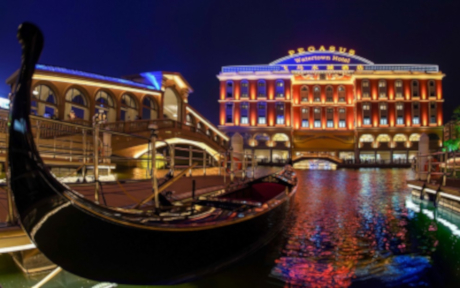Cooke Lenses Interview 4: How Director Shen Chenyan Used Cooke Panchro/i Classic Lenses To Create An Advertisement Cloaked In Mystery

Heilan Pegasus Aqua City is a comprehensive equestrian facility by China Heilan Group that brings equestrian training, performance, competition, and recreation services under one roof. It features an equestrian performance hall, horse culture museum, art museum, the Marrisle Boutique Leisure Resort, Taoyuan Resort, and Pegasus Watertown Hotel in a large-scale integrated tourism complex. Recently, Nanjing Dacheng Dongfeng Film and Television Culture Communication Co., Ltd. produced an advertisement for Heilan Pegasus Aqua City. Director Shen Chenyan used a ‘cloaked in mystery’ concept and the Cooke Panchro/i Classic lenses to tell a beautiful 83-second story of Heilan Pegasus Aqua City as a lifelong companion to the leading couple.
You have completed filming for the Heilan Pegasus Aqua City advertisement. What impression did it leave you?
Shen Chenyan: The client was Heilan Home and the project was to produce the main advertisement for Heilan Pegasus Aqua City in Wuxi, Jiangsu. The client’s main objectives were, firstly, to raise people’s awareness and understanding of Heilan Pegasus Aqua City, and secondly, to attract more tourists. Pre-production took more than two months. Because I live in Nanjing, after the proposal had been completed and approved in Beijing, I returned home. After that, it was a busy period of surveying locations, planning scenes with the creative director, designing shots, searching for references, and other preparation work. I do not like to rush through my projects. Where possible, I prefer to spend more time making meticulous preparations.
A typical advertisement presents whatever there is to present. Our thought process was the reverse. We attempted to use many techniques typically seen in movie trailers to create a water town filled with mystique. More specifically, we used partial shots of Heilan Pegasus Aqua City, quick cuts, and a mysterious atmosphere to attract viewers who are unfamiliar with the place—to show them that such an enigmatic place does exist in China. Together with our storyline and visual imaging approach, we were able to create a highly stylised advertisement.
When filming the Heilan Pegasus Aqua City advertisement, what was the cinematic style that you wanted?
Shen Chenyan: The tempo of the advertisement shifted between the two extremes of fast and slow. The fast-tempo scenes would suddenly slow down, then pick up pace again. This is actually the typical tempo of a movie trailer. From the beginning, we wanted to adopt such an approach for this advertisement so the scenes had to convey mysteriousness. We avoided broad, wide-angle shots, with the exception of the closing scene, because I did not want viewers to develop a panoramic impression of the complex. In terms of composition, we mainly used partial shots of the facility. On location, our cinematographer Xiao Pulun had actually captured some amazing full and long-range shots. But in the final cut, in consideration of the overall visual effect, we did not use them. That was a pity.
Most of the shots in the final advertisement were created with 18mm, 25mm, and 35mm lenses. Wide angles give people a sense of closeness. These focal lengths are also closer to the cinematic style of movies. In this advertisement, we had a very short time to tell the story of a couple in reverse time, from old age to childhood, so we used different cinematic styles to present different parts of the story.
For example, when the advertisement opens in the granny’s home, the tone of the scene is warm. The early morning light streams into the old house, creating a misty, somewhat fantasy-like atmosphere. When this cuts to Heilan Pegasus Aqua City, the shot is crystal clear—as if fantasy is actually reality. As we move into their middle-age years, the scenes are colour-faded to give a touch of old Shanghai’s luxury and elegance. In their youth, the scenes are bright and vividly coloured. With a push of the door, it feels like you are stepping into a grand palace ball filled to the brim with dreaminess. Finally, when we reach their childhood, the scenes are fairytale-like and the colours are richer. That is the entire style structure of the advertisement that we planned.
Prior to filming the Heilan Pegasus Aqua City advertisement, what technical tests did you conduct? How did you choose your camera and lenses?
Shen Chenyan: We were choosing between the RED GEMINI 5K and the ALEXA Mini. Eventually, for better coordination with the equipment available at the filming site and given our budget, I decided on the ALEXA Mini, which I am more familiar with. I toyed with the idea of using anamorphic lenses but decided against it for various reasons. Our budget allowed us to use either UP or Cooke lenses. Because we were certain that we wanted highly stylised imagery for this advertisement, we went with Cooke .
I am very familiar with the S4/i. I shot an art film with it a few months ago and often use it in advertisements as well. The timing of this project coincided with the delivery of the Panchro/i Classic lenses that I had ordered. Its cinematic style is stronger than the S4/i’s and, since we wanted to produce a highly stylised advertisement, we left we could not go wrong with the Panchro/i Classic. As a creator, I feel that an understanding of my equipment is predicated by my ability to control the images it produces. I do not believe that certain equipment can only be used on certain subject matter. We also used GoPro and OSMO to film a handful of scenes and used some pre-shot SLR material as well.
When filming the Heilan Pegasus Aqua City advertisement, which scenes made the deepest impression on you?
Shen Chenyan: What left quite a deep impression on me is how difficult it is to film horses. In all our scenes, there were people riding the horses, so that made it relatively easier to control. One problem was, during the childhood scenes, we had small pony that was not very obedient. Plus, every time we turned on the water fountain pump, it made a loud sound that startled the pony. We were really worried that it would knock into the child actors. It took a lot of effort to complete those scenes. When it comes to filming animals, no matter how well-prepared you are, the unexpected will always happen.
We also faced some difficulty filming the part with clowns. The firework sparklers that we used are actually prohibited items and really hard to find. We managed to get several of them, but we had to plan every shot carefully—we only had enough for two or three takes. After lots of practice, we succeeded in getting the shot after just one or two tries.
This filming experience also altered my perspective when it comes to the use of art. Sometimes, it just takes few extra elements to completely change the visual effect. I am grateful to Cinematographer Xiao Pulun and Art Director Peng Ming for creating such perfection. For example, in the final water fountain scene, I did not plan to have so many elements but now, the image looks richer and fuller. Pulun suggested adding props like a carriage, tent, and balloons, and it turned out great. For the ballroom dancing scene, after we added some inexpensive lamps to the background, the visual effect was also totally different.
Overall, how do you feel about the Cooke Panchro/i Classic’s performance?
Shen Chenyan: While the Panchro/i Classic produces more highly stylised images, its out-of-focus imaging is different from the S4/i’s. It is not as extreme and has a soft, roundedness to it. Also, I did not feel that there was much distortion with the Panchro/i Classic. It did not interfere with my work. The strongest impression that I have of the Panchro/i Classic is how it softens the image and creates a fantasy-like mood. Even though we did colourisation and light adjustments for this advertisement, the Panchro/i Classic was a great help in achieving the highly stylised look that we were after.
I personally like using different filters and have bought many. From an artistic perspective, there are scenes where the use of filters can completely transform the visual effect. For the Heilan Pegasus Aqua City advertisement, we added filters like Blackmagic. It is indispensable for stylised images.
How would you define the Cooke Look? After this filming experience, is there anything that you would like to share with your industry peers?
Shen Chenyan: In my opinion, the Cooke Look is an overarching concept for the brand’s lenses but, to understand it, you cannot stop at the lenses’ visual performance. For example, I earlier mentioned lens distortion and a vintage look. I think the Cooke Look is a perspective. Using the Heilan Pegasus Aqua City advertisement as an example, it is nostalgic and reminiscent of the good old days; a fantasy-like expression of the real world. The world that the Cooke Look creates is truly one of its kind.
I previously filmed a realism movie in Sichuan. As the cinematographer, I used the S4/i because I did not want to present reality in a very realistic manner. In such circumstances, Cooke Look softens reality; it understands and embraces the cruelty of life. I feel that the CookeLook is that kind of perspective and attitude. It is hard to describe it in technical terms.
How will new technologies impact the industry? What are your thoughts on the full frame format?
Shen Chenyan: I have always felt that the impact of technology depends on how you use it in your creations. I do not think that the most advanced technology is necessarily the best—only the most suitable is the best. At the core of technology advancements is how it helps us lower production costs. That is a very practical consideration. For example, film was expensive but now, we have digital cameras to produce better work.
I think that full frame technology is not completely mature yet. While the S35 format is getting smaller and smaller, full frame seems to be distancing itself from technology trends. Let’s take top-of-the-line productions out of the picture first. Practically speaking, a mid-range advertisement or mid-to-low budget movie can only work with portable technology. In order for full frame to be widely used, I think it needs a lightweight and portable camera like the ALEXA Mini. Another consideration is cost. Full frame is still very expensive. It does deliver a different visual performance and there will certainly always be productions that can afford it but, in the long run, I think cost will be a major barrier to its popularity. It was the same for the digital 65mm. While it was very expensive, its technology advancements were able to reduce overall production costs compared to film. Full frame may be a great alternative and it may be technologically superior, but I think it will still need more time to become mainstream.
How would you evaluate Cooke ’s positioning in the cinematic lens market? Is there anything you would like to share with your industry peers?
Shen Chenyan: I cannot claim to be deeply familiar with the optical design aspects of Cooke lenses, but, at the end of the day, the core of technology lies in how people use it. For cinematic lenses, it does not mean that the better the image authenticity, the better the lenses. The two are not mutually exclusive. Another aspect is the market. Cooke ’s current positioning is built on the positive feedback that it has received from the market. And I think the market definitely needs a brand like Cooke , one that dares to pursue its own direction. Otherwise, every cinematic work will end up looking exactly the same. How boring! The greatest contribution that Cooke has made to movies, advertisements, and cinematographers is providing the most stylised product range. Of course, Cooke lenses have achieved a good balance—great style, great quality. Stylisation can take many forms and, if we accept technical shortcomings as a form of style, then the choices are endless. The difference is, Cooke offers stylised images that are easy for cinematographers to control. I do not have much to add in terms of technical details, but I know when and how I can Cooke lenses to express my creative perspective.
As I mentioned earlier, there may be people who think that stylised cinematic lenses are unsuitable for realistic subject matters. But, for the film that I shot with the Cooke S4/i, I chose the lenses not only for a fantasy-like or nostalgic mood. In fact, that the film’s colour tone was quite cold. It deals with issues at the bottom of society. There are times when you need a sense of detachment. When you want to express understanding and empathy towards reality, Cooke Look creates a distance; a kind of detached observation. But it is not absolute. Please do not try to define Cooke Look or Cooke lenses in this way, and definitely do not misunderstand that Cooke lenses are only suitable for certain subject matters. You should first be clear about your perspective, then consider how you can leverage the characteristics of your lenses to bring out your perspective—not the other way around. When you have developed your own perception of beauty, the way you see stories will become vastly different.
Title: Advertisement “Heilan Pegasus Aqua City”
Director: Shen Chenyan
Cinematographer: Xiao Pulun
Production House: Nanjing Dacheng Dongfeng Film and Television Culture Communication Co., Ltd.
Images provided by: Shen Chenyan


